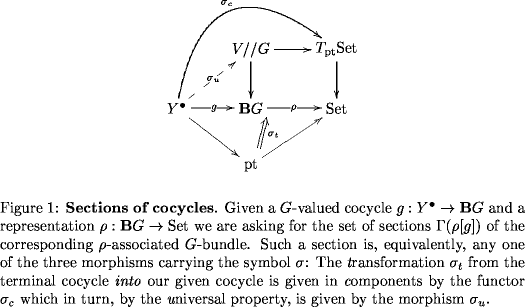101 things to do with a 2-classifier
Posted by David Corfield
Thanks to Tom and Todd, I have an answer to the problem I posed of what does the classifying for 2-categories.
- At level 0, we have the set inclusion .
- At level 1, we have the forgetful functor .
- At level 2, we have the forgetful 2-functor .
is what I’m calling the 2-category of pointed categories , but where a map is a functor together with a map in .
If there’s a name already for this 2-category, do please let me know.
On the royal road to categorified logic, let’s see if I can understand the answer in terms of some of the examples I had in mind:
a) Mapping a 2-group, , into Cat.
Here is taken as a 1 object 2-groupoid. So we’re looking then at permutation 2-representations of . Do people study these?
Above we should have the action 2-groupoid. Let’s say the single object of was sent to , so we’re after a 2-groupoid . (One might argue that it should be , the really weak quotient. Perhaps the notation isn’t too good.)
has as objects the objects of . A map is a 1-morphism in together with a map in . The 2-morphisms of can wait.
b) Mapping the 2-category Th(2-gp) (theory of 2-groups) into Cat.
Surely someone must have worked out 2-theories as 2-categories. Do you get a nice duality as between Th(gp) and Free groups?
Presumably fibred above Th(2-gp) for a given functor into Cat, you’d have specific maps such as between pairs of objects of that category and a third object, with a comparison map between the monoidal product of the pair and the third object. So essentially encoding the weakness and coherence conditions.
c) Mapping the fundamental 2-groupoid of a space, such as the 2-sphere, into Cat.
So over this 2-groupoid we have another 2-groupoid, with as objects pairs consisting of a point of the 2-sphere and an object in the fibre category. A map between such pairs is a path between the corresponding points on the sphere, together with a map in the fibre over the second point from the endpoint of the lift of the path to the designated object. (No doubt some symbols would have helped here.) Again 2-morphisms are needed.
Is this a well-known construction?


Re: 101 things to do with a 2-classifier
Something tells me I need a crash course in fibred categories. Maybe Thomas Streicher’s notes.